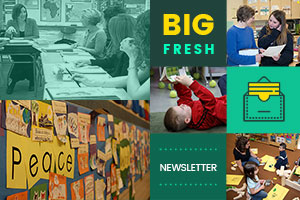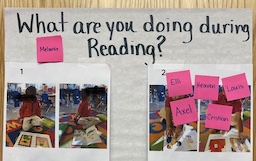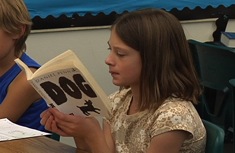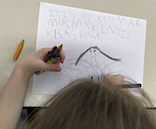Library
Choice Literacy Articles & Videos
The Choice Literacy library contains over 3,000 articles and 900 videos from 150+ contributors. Classic Classroom and Literacy Leadership subscribers have access to the entire library. Content is updated continuously, with five to six new features published each week.
Latest Content
July 28, 2023: Reaching Readers
This week’s newsletter is about reaching all readers by deepening our instruction.
Creating Learning Progressions with Students
Tara Barnett and Kate Mills outline the steps to involve students in defining how to progress as readers and then set goals. They offer a practical plan for empowering students to take ownership of their learning.
Getting Ready to Read
Dana Murphy encourages us to go beyond teaching students to recognize different genres by helping them establish expectations of genres so they’ll be ready to read.
July 21, 2023: Routines for Readers
This week’s newsletter is about establishing routines for readers.
Emoji Book Talks
Jen Vincent outlines a twist on book talks—the Emoji Book Talks. This is a fast and fun way for students to share books and build their Books to Read lists.
Middle School Reading Routines
Tara Barnett and Kate Mills share ways to establish middle school reading routines. They share two downloads to help support reading routines in all classrooms.
July 14, 2023: Encouraging Independence
This week’s newsletter is about encouraging independence in learners.
Managing Your Students’ Independent Work During Guided Reading
Are you ready to ditch small-group instruction because it seems too difficult for students to work independently? Lisa Mazinas compiled a helpful chart to problem solve common classroom issues and support student independence.
Small-Group Conversations About Independent Reading
Jen Vincent scaffolds conversations to help students discuss their independent reading books in small groups…even when everyone is reading a different book! Download and print a copy of the guide to support students in their small-group conversations.
June 16, 2023: Independence in Writers
This week’s newsletter is about creating space for independence for writers.
Developing Independent Writers
Vivian Chen tackles the difficult topic of helping students become independent as writers. She offers tips for before, during, and after writing time to uplift student agency.
Encouraging Agency
Melanie Meehan shares three tips on helping students be independent and productive writers. She also includes a hefty list of craft moves from mentor texts to use while teaching writers.
June 9, 2023: Graphic Novels
This week’s newsletter is about graphic novels.
Learning from Our Favorite Illustrators
Ruth Metcalfe tapped a plethora of resources to help her first-grade writers understand how to communicate meaning with illustrations.
Writing Graphic Novels
Melanie Meehan shares the immersion process of writing graphic novels with middle grade students. You won’t want to miss the incredible student writing that shows the power of offering choice to young writers.
Graphic Engagement
Joanne Emery supports students as readers and writers of graphic novels. Included is a list of resource books and websites, as well as students’ favorite graphic novels.
June 2, 2023: Uplifting Student Voices
This week’s newsletter is about uplifting student voices.
May 26, 2023: Extending Empathy
This week’s newsletter is about extending empathy.
The Language We Use and How It Strengthens Understanding
Suzy Kaback explores the importance of the way teachers use language and invite kids to use theirs. It is the key to knowing ourselves, tuning in to others, and understanding the larger world.
What’s Your Point of View?
Molly James helps us develop an essential point of view for uplifting choice in decision making for young writers and readers.
Alert! Mistakes in Progress
Becca Burk gives the science behind mistakes and growth, and offers suggestions on ways to use mistakes as a means to help students become critical thinkers and problem solvers.
Overcoming Challenges in Writing Workshop with Trauma-Informed Practices
Ruth Ayres shares three mindsets to help teachers prioritize connection over correction when teaching writers.
May 19, 2023: Celebrations
This week’s newsletter is about celebrations.
May 12, 2023: Opinion Writing
This week’s newsletter is about opinion writing.
QuickTake: Grading Student Writing
Ruth Ayres shares a process for grading student writing that improves efficiency and accuracy.
Young Author Celebrations
Jennifer Court shares the celebrations that propel students to engage in the Young Authors Program.
It’s Time to Admire: Sharing in the Beauty of Students’ Writing
Heather Fisher shares a process to help teachers learn to admire student writers and find the beauty in their work.
May 5, 2023: Our Youngest Readers
This week’s newsletter is about teaching primary readers.
Opinion Writing in Primary Grades: Layers of Support
Ruth Metcalfe suggests several layer of supports to uplift young writers as they begin to write their opinions.
Taking a Stance: Supporting Opinions in Primary Writers
Josie Stewart and Hannah Tills expand their view of opinion writing to taking a stance, and are reminded of the power of choice and honoring student passions and interests. At the same time, students are reminded that their voice is heard and their opinions matter.
Browse Content By
Type
Category
- Assessment Tools
- Big Fresh Archives
- Booklists
- Choice Numeracy
- Classroom Design
- Common Core
- Community Building
- Conferring
- Content Literacy
- Digital Literacy
- English Language Learners
- Equity
- Family Relations
- Free Samples
- Guiding Groups
- Leadership
- Literacy Coaches
- Mentor Texts
- Minilessons
- New Teacher Mentors
- Podcasts
- Poetry
- Quote Collections
- Reading Strategies
- Self Care
- Struggling and Striving Learners
- Talking and Listening
- Teacher Study Groups
- Teaching Reading
- Teaching Writing
- Word Study and Vocabulary
Author
- Melissa Quimby
- Nawal Qarooni
- Gwen Blumberg
- Julie Cox
- The Lead Learners
- Hannah Tills
- Josie Stewart
- Ruth Metcalfe
- Mallory Messenger
- Becca Burk
- Jodie Bailey
- Vivian Chen
- Mary Brower
- Tiffany Abbott Fuller
- Stephanie Affinito
- Ruth Ayres
- Leigh Anne Eck
- Heather Fisher
- Shari Frost
- Julie Johnson
- Suzy Kaback
- Gigi McAllister
- Shirl McPhillips
- Melanie Meehan
- Cathy Mere
- Debbie Miller
- Tara Barnett and Kate Mills
- Tammy Mulligan
- Dana Murphy
- Bitsy Parks
- David Pittman
- Brenda Power
- Heather Rader
- Matt Renwick
- Mandy Robek
- Christy Rush-Levine
- Gretchen Schroeder
- Jen Schwanke
- Brian Sepe
- Katherine Sokolowski
- Stella Villalba
- Jennifer Vincent
Grade Level
Choice Literacy Membership
Articles
Get full access to all Choice Literacy article content
Videos
Get full access to all Choice Literacy video content
Courses
Access Choice Literacy course curriculum and training




















